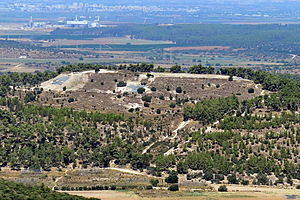
The history of ancient Israel and Judah begins in the Southern Levant region of Western Asia during the Late Bronze Age and Early Iron Age. "Israel" as a people or tribal confederation appears for the first time in the Merneptah Stele, an inscription from ancient Egypt that dates to about 1208 BCE. According to modern archaeology, ancient Israelite culture developed as an outgrowth from the Semitic Canaanites. Two related Israelite polities known as the Kingdom of Israel (Samaria) and the Kingdom of Judah had emerged in the region by Iron Age II.

The Kingdom of Judah was an Israelite kingdom of the Southern Levant during the Iron Age. Centered in Judea, the kingdom's capital was Jerusalem. The other Israelite polity, the Kingdom of Israel, lay to the north. Jews are named after Judah and are primarily descended from it.
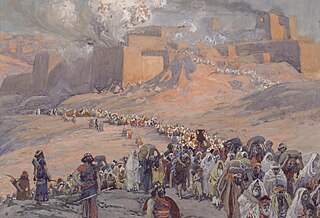
The Babylonian captivity or Babylonian exile is the period in Jewish history during which a large number of Judeans from the ancient Kingdom of Judah were captives in Babylon, the capital city of the Neo-Babylonian Empire, following their defeat in the Jewish–Babylonian War and the destruction of Solomon's Temple in Jerusalem. The event is described in the Hebrew Bible, and its historicity is supported by archaeological and extra-biblical evidence.
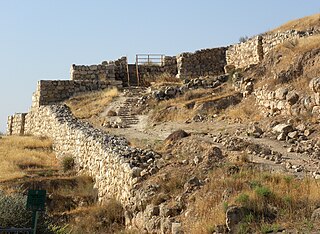
Lachish was an ancient Canaanite and Israelite city in the Shephelah region of Israel, on the South bank of the Lakhish River, mentioned several times in the Hebrew Bible. The current tell (ruin) by that name, known as Tel Lachish or Tell ed-Duweir ,, has been identified with the biblical Lachish. Today, it is an Israeli national park operated and maintained by the Israel Nature and Parks Authority. The park was established on lands of the depopulated Palestinian village of Qobebet Ibn ‘Awwad which was north of the Tel. It lies near the present-day moshav of Lakhish.

Israel Finkelstein is an Israeli archaeologist, professor emeritus at Tel Aviv University and the head of the School of Archaeology and Maritime Cultures at the University of Haifa. Finkelstein is active in the archaeology of the Levant and is an applicant of archaeological data in reconstructing biblical history. He is also known for applying the exact and life sciences in archaeological and historical reconstruction. Finkelstein is the current excavator of Megiddo, a key site for the study of the Bronze and Iron Ages in the Levant.
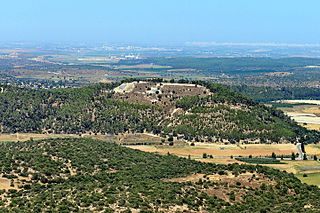
Azekah was an ancient town in the Shfela guarding the upper reaches of the Valley of Elah, about 26 km (16 mi) northwest of Hebron.

The United Monarchy is a political entity described in the Hebrew Bible as encompassing the territories of the later kingdoms of Israel and Judah under the reigns of Saul, David, and Solomon. Whether the United Monarchy actually existed is a matter of ongoing academic debate, and scholars remain divided between those who support the historicity of the biblical narrative, those who doubt dismiss it, and those who support the kingdom's theoretical existence while maintaining that the biblical narrative is exaggerated. Proponents of the kingdom's existence traditionally date it to between c. 1047 BCE and c. 930 BCE.

Ramat Rachel or Ramat Raḥel is a kibbutz located in central Israel. An enclave within Jerusalem's municipal boundaries and overlooking Bethlehem and Rachel's Tomb, it falls under the jurisdiction of Mateh Yehuda Regional Council. In 2019, it had a population of 545.

The Aeolic order or Aeolian order was an early order of Classical architecture. It has a strong similarity to the better known Ionic order, but differs in the capital, where a palmette rises between the two outer volutes, rather than them being linked horizontally by a form at the top of the capital. Many examples also show simplified details compared to the Ionic.
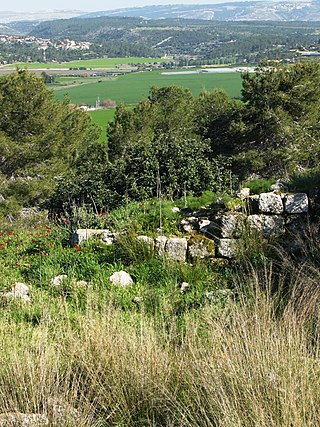
Sokho is the name given to two ancient towns in the territorial domain of Judah as mentioned in the Hebrew Bible, west of the Judean hills. Both towns were given the name Shuweikah in Arabic, a diminutive of the Arabic shawk, meaning "thorn". The remains of both have since been identified.
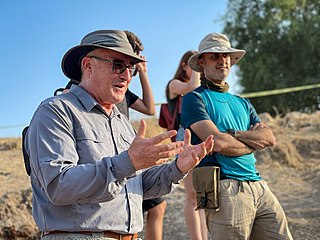
Aren Maeir is an American-born Israeli archaeologist and professor at Bar Ilan University. He is director of the Tell es-Safi/Gath Archaeological Project.
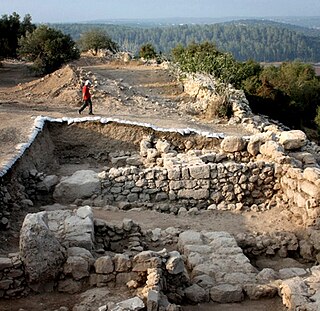
Khirbet Qeiyafa, also known as Elah Fortress and in Hebrew as Horbat Qayafa, is the site of an ancient fortress city overlooking the Elah Valley and dated to the first half of the 10th century BCE. The ruins of the fortress were uncovered in 2007, near the Israeli city of Beit Shemesh, 30 km (20 mi) from Jerusalem. It covers nearly 2.5 ha and is encircled by a 700-meter-long (2,300 ft) city wall constructed of stones weighing up to eight tons each. Excavations at site continued in subsequent years. A number of archaeologists, mainly the two excavators, Yosef Garfinkel and Saar Ganor, have claimed that it might be one of two biblical cities, either Sha'arayim, whose name they interpret as "Two Gates", because of the two gates discovered on the site, or Neta'im; and that the large structure at the center is an administrative building dating to the reign of King David, where he might have lodged at some point. This is based on their conclusions that the site dates to the early Iron IIA, ca. 1025–975 BCE, a range which includes the biblical date for the biblical Kingdom of David. Others suggest it might represent either a North Israelite, Philistine, or Canaanite fortress, a claim rejected by the archaeological team that excavated the site. The team's conclusion that Khirbet Qeiyafa was a fortress of King David has been criticised by some scholars.

The siege of Jerusalem was the final event of the Judahite revolts against Babylon, in which Nebuchadnezzar II, king of the Neo-Babylonian Empire, besieged Jerusalem, the capital city of the Kingdom of Judah. Jerusalem fell after a 30-month siege, following which the Babylonians systematically destroyed the city and the First Temple. The Kingdom of Judah was dissolved and many of its inhabitants were exiled to Babylon.

The return to Zion is an event recorded in Ezra–Nehemiah of the Hebrew Bible, in which the Jews of the Kingdom of Judah—subjugated by the Neo-Babylonian Empire—were freed from the Babylonian captivity following the Persian conquest of Babylon. After their release, the Persian king Cyrus the Great issued a proclamation known as the Edict of Cyrus that enabled the freed Jewish populace, exiled from Judah, to return to Jerusalem and the Land of Judah, which had begun to function as a self-governing Jewish province under the Achaemenid Persian Empire.
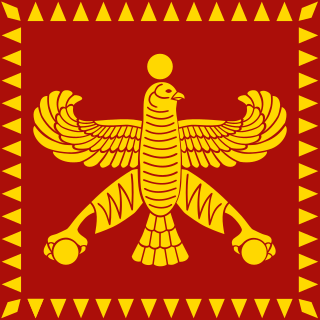
Yehud, also known as Yehud Medinata or Yehud Medinta, was an administrative province of the Achaemenid Persian Empire in the region of Judea that functioned as a self-governing region under its local Jewish population. The province was a part of the Persian satrapy of Eber-Nari, and continued to exist for two centuries until its incorporation into the Hellenistic empires following the conquests of Alexander the Great.
Yehud was a province of the Neo-Babylonian Empire established in the former territories of the Kingdom of Judah, which was destroyed by the Babylonians in the aftermath of the Judahite revolts and the siege of Jerusalem in 587/6 BCE. It first existed as a Jewish administrative division under Gedaliah ben Aḥikam, who was later assassinated by a fellow Jew. The Fast of Gedaliah, a minor fast day in Judaism, was established in memory of this event, and is lamented by observant Jews even to this day.
Tel Motza or Tel Moẓa is an archaeological site in Motza, on the outskirts of Jerusalem. It includes the remains of a large Neolithic settlement dated to around 8600–8200 BCE, and Iron Age Israelite settlement dating to around 1000 to 500 BCE and identified with the biblical Mozah mentioned in the Book of Joshua. In 2012, Israeli archaeologists announced the discovery of a temple from the Iron Age IIA levels at Motza, contemporary with the First Temple in Jerusalem.

Jacob L. Wright is a biblical scholar currently serving as associate professor of Hebrew Bible at Emory University, and sits as chair of Hebrew Bible in the Graduate Division of Religion. Prior to his Emory appointment, Wright taught at the University of Heidelberg (Germany), one of the foremost research-oriented public universities in Europe, for several years. His areas of expertise include Biblical Archaeology, warfare in the Ancient Near East, and the literary and redaction history of the Hebrew Bible canon. He has published extensively throughout his career, authoring several books and dozens of articles which span topics such as Ezra-Nehemiah, the Persian period, warfare in the Ancient Near East; as well as the material culture of the ancient Levant, the unique role of women in the Hebrew Bible, and larger themes such as defeat, peoplehood, and national identity in the Hebrew Bible. Areas of concentration in war studies include war commemoration, urbicide and ritual violence, and feasting and gift-giving.
The Book of Joshua lists almost 400 ancient Levantine city names which refer to over 300 distinct locations in Israel, the West Bank, Jordan, Lebanon and Syria. Each of those cities, with minor exceptions is placed in one of the 12 regions, according to the tribes of Israel and in most cases additional details like neighbouring towns or geographical landmarks are provided. It has been serving as one of the primary sources for identifying and locating a number of Middle Bronze to Iron Age Levantine cities mentioned in ancient Egyptian and Canaanite documents, most notably in the Amarna correspondence.
Nadav Na'aman is an Israeli archaeologist and historian. He specializes in the study of Near East in the second and first millenniums BC. His research combines the history of the Ancient Near East, archaeology, Assyrology, and the study of the Bible. He possesses broad knowledge in all these four branches of research.


